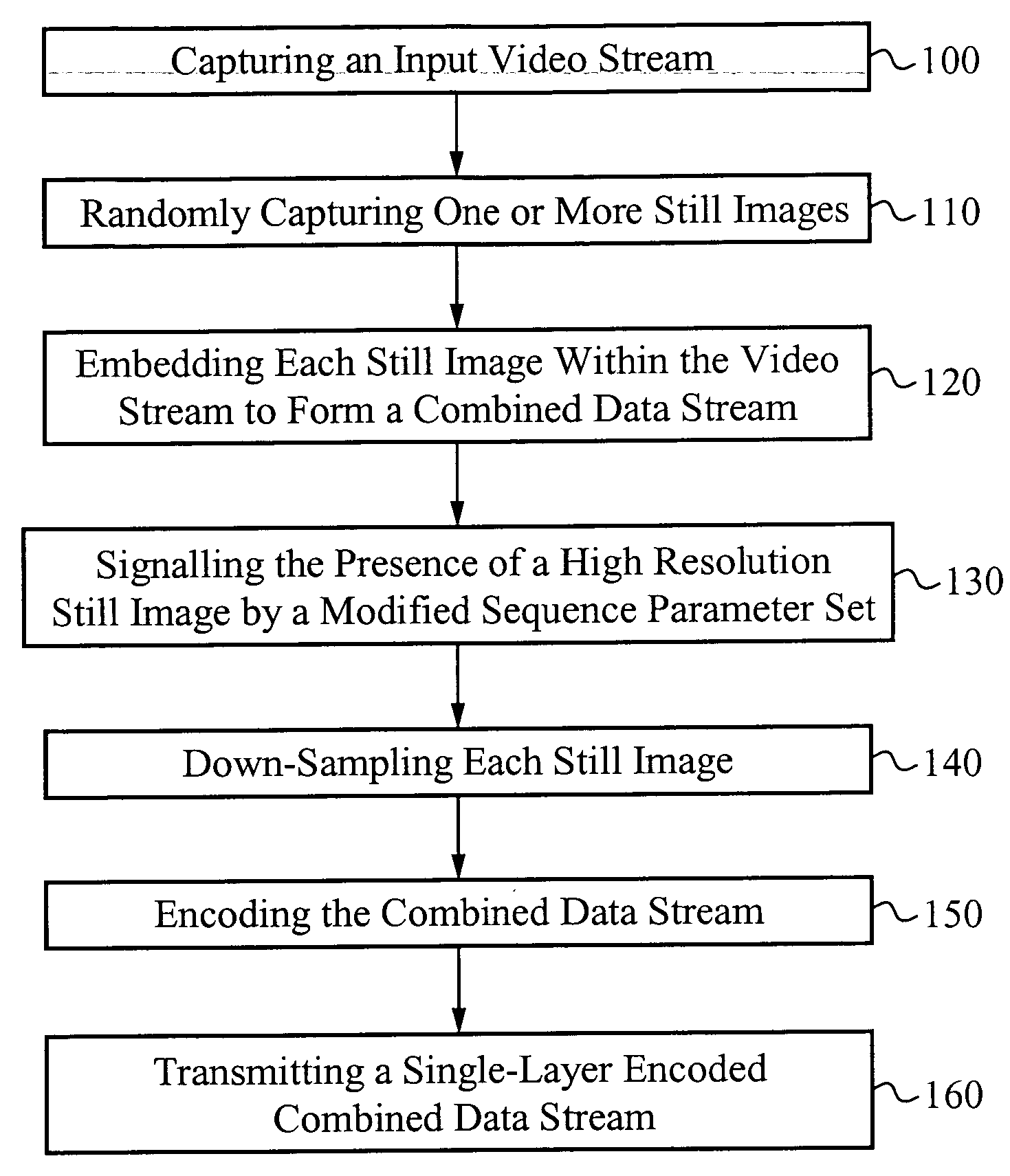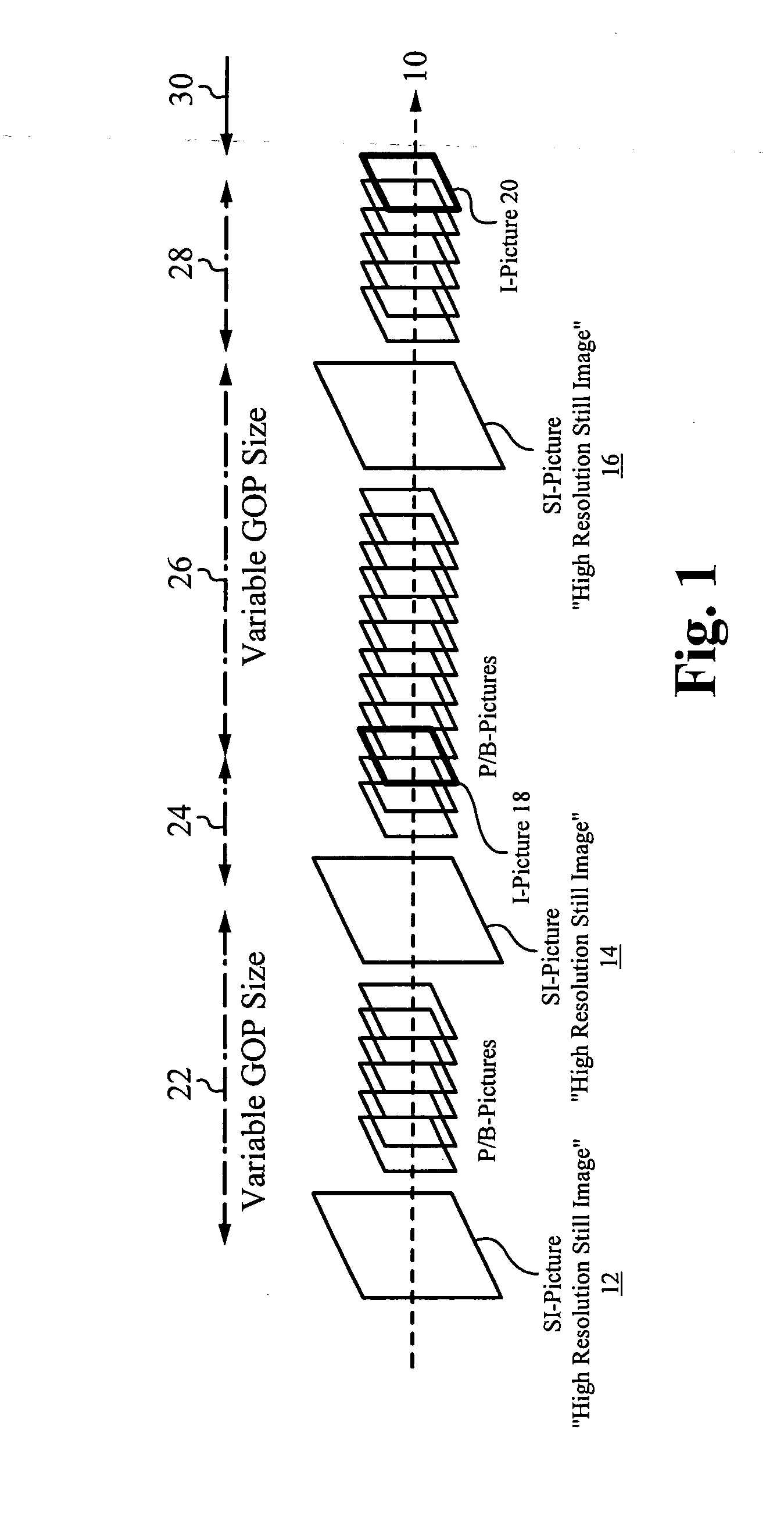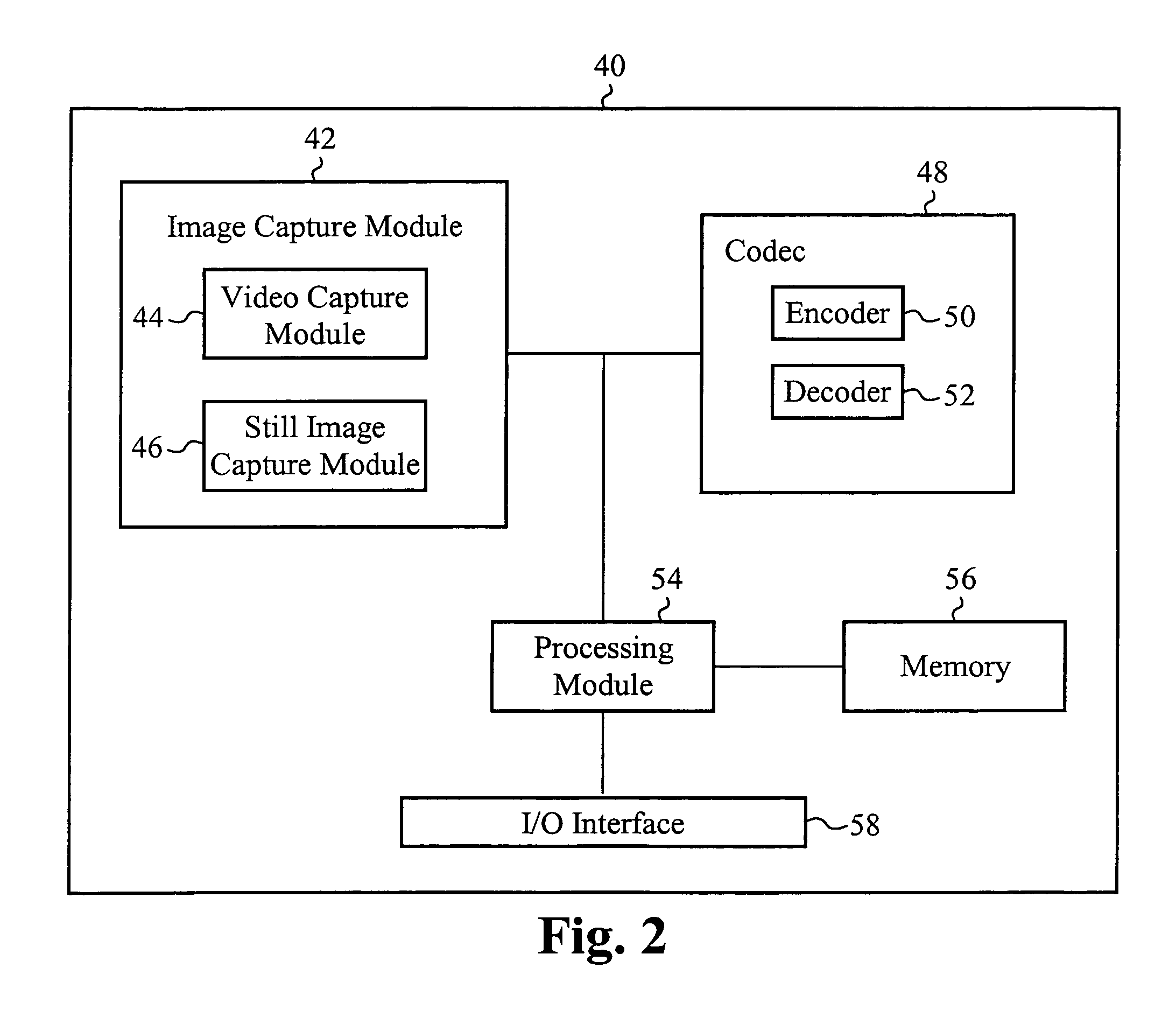[0029]A codec configured to operate in a sequential mode extends the current AVC standard in order to provide support for coding high resolution still image pictures within the AVC coding of a lower resolution video. The sequential mode codec is configured according to the modified AVC standard. The codec is capable of capturing an AVC video stream while concurrently capturing high resolution still images at random intervals relative to the video stream. Each captured high resolution still image is embedded within the video stream. The video stream including the embedded high resolution still images is encoded as a single layer bit stream. Each embedded high resolution still image signals or forces the start of a new GOP in the coded video sequence. The single-layer bit stream is transmitted from an encoder on the transmission side to a decoder on the receiving side.
[0030]To include the embedded high resolution still images in a video stream, the AVC standard is extended to include new syntax for the sequence parameter sets. In one embodiment, a modified sequence parameter set defines a new profile that signals the presence of a high resolution still image in sequence with AVC video.
[0031]In one aspect, a method of encoding data is described. The method includes capturing a video stream of data, wherein the video stream includes a plurality of successive video frames of data, capturing one or more still images, wherein each still image is captured at a random interval of time relative to the video stream, embedding each still image within the video frames in series, thereby forming a combined data stream, signaling a presence of a high resolution still image by using a new profile definition in a modified sequence parameter set, encoding the combined data stream, and transmitting the encoded combined data stream as a single-layer transmission. The method can also include down-sampling each captured high resolution still image and storing a down-sampled version of each still image for use as a reference image for subsequent frames in the video stream. The method can also include converting image characteristics associated with each captured still image to video characteristics such that the down-sampled version of each still image matches the characteristics of the video. Encoding the combined data stream can include encoding the video frames according to the down-sampled version of each still image. Each embedded still image can indicate a new GOP. Each still image can be randomly embedded within the combined data stream. Each GOP can be variable in size. The combined data stream can be encoded according to a modified AVC standard. The method can also include receiving the single-layer transmission, detecting an occurrence of each embedded still image by a presence of a modified sequence parameter set, decoding each detected still image, and decoding each video frame. The method can also include down-sampling each decoded still image and storing a down-sampled version of each still image. The method can also include converting image characteristics associated with each decoded still image to video characteristics such that the down-sampled version of each still image matches the characteristics of the video stream. Decoding each video frame can include decoding each video frame according to the down-sampled version of each still image if the still image is used as a reference for prediction. Each still image can comprise a high resolution still image. Each video frame can comprise a low resolution video frame. A frame rate of the video stream can be independent of a frame rate of the one or more still images.
[0032]In another aspect, a system to encode-data is described. The system includes a video capturing module to capture a video stream of data, wherein the video stream includes a plurality of successive video frames of data, a still image capturing module to capture one or more still images, wherein each still image is captured at a random interval of time relative to the video stream, a processing module to embed each captured still image within the video frames and to set a modified sequence parameter set to signal a presence of each still image, thereby generating a combined data stream, an encoder to encode the combined data stream, thereby forming an encoded combined data stream, and a transmitter to transmit the encoded combined data stream as a single-layer transmission. The encoder can include a down-sampling module to down-sample each still image and a buffer to store a down-sampled version of each still image. The encoder can be configured to convert image characteristics associated with each captured still image to video characteristics such that the down-sampled version of each still image matches the characteristics of the video. The encoder can be configured to encode the combined data stream by encoding the video frames according to the down-sampled version of each still image. The processing module can be configured to define a modified sequence parameter set and add the parameter set at every occurrence of the still image in the video stream to signal a presence of the still image and start of a new GOP. The processing module can also be configured to define one or more still image parameters, wherein each still image parameter defines a characteristic of the still image such as one or more of image height and image width. Each embedded still image can indicate a new GOP. Each still image can be randomly embedded within the combined data stream. Each GOP can be variable in size. The combined data stream can be encoded according to a modified AVC standard. Each still image can comprise a high resolution still image. Each video frame can comprise a low resolution video frame. A frame rate of the video stream can be independent of the frame rate of the one or more still images.
[0033]In yet another aspect, a system to decode data is described. The system includes a receiver to receive an encoded data stream as a single-layer transmission, wherein the encoded data stream includes one or more still images embedded within a plurality of video frames, a processing module to detect a presence of an embedded still image by parsing contents of a modified sequence parameter set, and a decoder to decode each still image embedded within the encoded data stream and to decode each encoded video frame to form a video stream of data, wherein each still image is decoded at a random interval of time relative to the video stream. The decoder can include a down-sampling module to down-sample each still image and a buffer to store a down-sampled version of each still image. The decoder can be configured to convert image characteristics associated with each decoded still image to video characteristics such that the down-sampled version of each still image matches characteristics of the video stream. The decoder can be configured to decode each encoded video frame by decoding each appropriate video frame according to the down-sampled version of each still image when the still image is used as a reference. The processing module can be configured to detect one or more still image parameters, wherein each still image parameter defines a characteristic of the still image such as one or more of image height and image width. Each embedded still image can indicate a new GOP. Each still image can be randomly embedded within the encoded data stream. Each GOP can be variable in size. The encoded data stream can be encoded according to a modified AVC standard. Each still image can comprise a high resolution still image. Each video frame can comprise a low resolution video frame. A frame rate of the video stream can be independent of a frame rate of the one or more still images.
[0034]In still yet another aspect, a system to encode and decode data is described. The system includes a video capturing module to capture a first video stream of data, wherein the first video stream includes a plurality of successive video frames of data, a still image capturing module to capture one or more still images, wherein each still image is captured at a random interval of time relative to the first video stream, a processing module to embed each captured still image within the video frames of the first video stream and to set a sequence parameter set to signal a presence of the still image, thereby generating a first data stream, an encoder to encode the first data stream, thereby forming a first encoded data stream, a transceiver to transmit the first encoded data stream as a first single-layer transmission, and to receive a second encoded data stream as a second single-layer transmission, and a decoder to decode each still image embedded within the second encoded data stream and to decode each encoded video frame within the second encoded data stream to form a second video stream of data. The encoder can include a down-sampling module to down-sample each still image and a buffer to store a down-sampled version of each still image. The decoder can include a down-sampling module to down-sample each still image and a buffer to store a down-sampled version of each still image.
 Login to View More
Login to View More  Login to View More
Login to View More 


